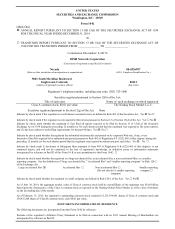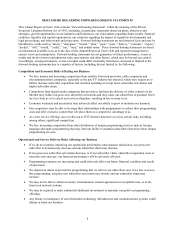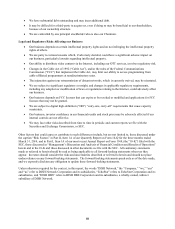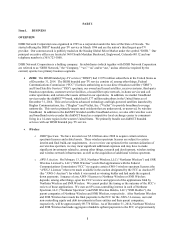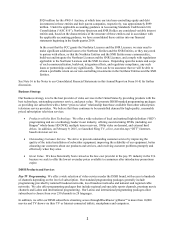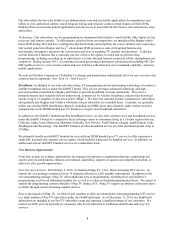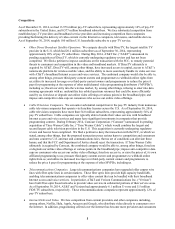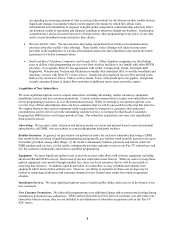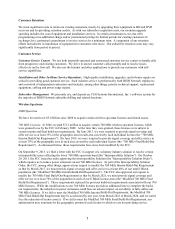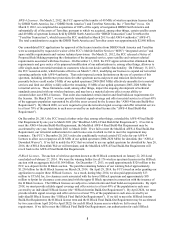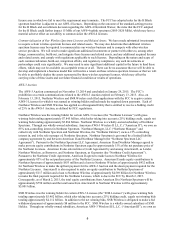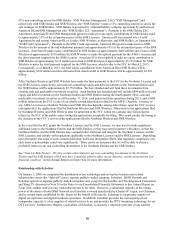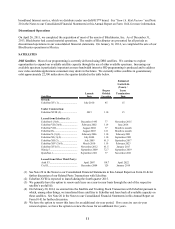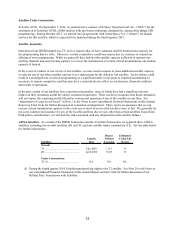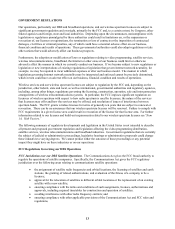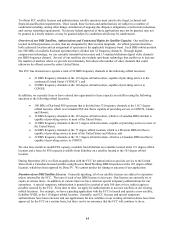Dish Network 2014 Annual Report Download - page 14
Download and view the complete annual report
Please find page 14 of the 2014 Dish Network annual report below. You can navigate through the pages in the report by either clicking on the pages listed below, or by using the keyword search tool below to find specific information within the annual report.4
4
Content Delivery
Digital Broadcast Operations Centers. The principal digital broadcast operations facilities that we use are
EchoStar’s facilities located in Cheyenne, Wyoming and Gilbert, Arizona. We also use seven regional digital
broadcast operations facilities owned and operated by EchoStar that allow us to maximize the use of the spot beam
capabilities of certain satellites. Programming content is delivered to these facilities by fiber or satellite and
processed, compressed, encrypted and then uplinked to satellites for delivery to consumers. EchoStar provides
certain broadcast services to us, including teleport services such as transmission and downlinking, channel
origination services, and channel management services pursuant to a broadcast agreement that expires on December
31, 2016. See Note 20 in the Notes to our Consolidated Financial Statements in this Annual Report on Form 10-K
for further discussion of our Related Party Transactions with EchoStar.
Satellites. Our DISH branded programming is primarily delivered to customers using satellites that operate in the
“Ku” band portion of the microwave radio spectrum. The Ku-band is divided into two spectrum segments. The
portion of the Ku-band that allows the use of higher power satellites (12.2 to 12.7 GHz over the United States) is
known as the Broadcast Satellite Service band, which is also referred to as the DBS band. The portion of the Ku-
band that utilizes lower power satellites (11.7 to 12.2 GHz over the United States) is known as the FSS band.
Most of our programming is currently delivered using DBS satellites. To accommodate more bandwidth-intensive
HD programming and other needs, we continue to explore opportunities to expand our satellite capacity through the
acquisition of additional spectrum, the launching of more technologically advanced satellites, and the more efficient
use of existing spectrum via, among other things, better modulation and compression technologies.
We own or lease capacity on 14 DBS satellites in geostationary orbit approximately 22,300 miles above the equator.
For further information concerning these satellites and satellite anomalies, please see the table and discussion under
“Satellites” below.
Conditional Access System. Our conditional access system secures our programming content using encryption so
that only authorized customers can access our programming. We use microchips embedded in credit card-sized
access cards, called “smart cards,” or security chips in our receiver systems to control access to authorized
programming content (“Security Access Devices”).
Our signal encryption has been compromised in the past and may be compromised in the future even though we
continue to respond with significant investment in security measures, such as Security Access Device replacement
programs and updates in security software, that are intended to make signal theft more difficult. It has been our
prior experience that security measures may only be effective for short periods of time or not at all and that we
remain susceptible to additional signal theft. We expect that future replacements of our Security Access Devices
will be necessary to keep our system secure. We cannot ensure that we will be successful in reducing or controlling
theft of our programming content and we may incur additional costs in the future if our system’s security is
compromised.
Distribution Channels
While we offer receiver systems and programming through direct sales channels, a significant percentage of our
gross new subscriber activations are generated through independent third parties such as small satellite retailers,
direct marketing groups, local and regional consumer electronics stores, nationwide retailers, and
telecommunications companies. In general, we pay these independent third parties a mix of upfront and monthly
incentives to solicit orders for our services and provide customer service. In addition, we partner with certain
telecommunications companies to bundle DISH branded programming with broadband and/or voice services on a
single bill.



